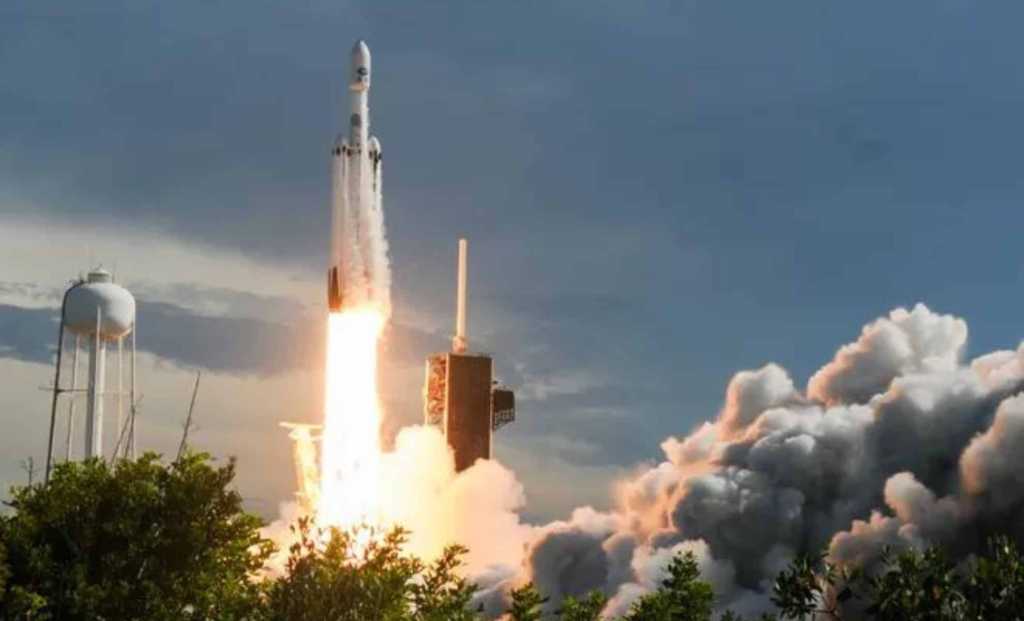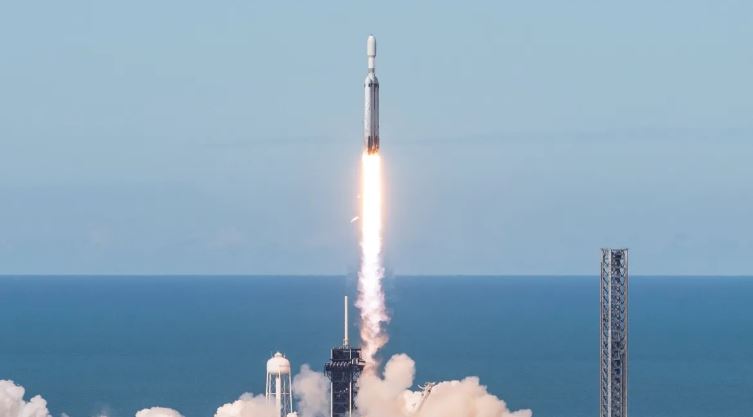After around half a year without a Falcon Heavy launch, the heavy-lift rocket just lifted off yesterday afternoon. On top was a NASA weather satellite named GOES-U, weighing in at around 5,000 kg (11,023lbs) and headed to a distant geostationary orbit.
This required the Falcon Heavy to launch in a partially expendable configuration, where the center core is expended while the two side boosters return to land to be refurbished and used again in the future. Here I will go more in-depth into the mission, the vehicle’s flight profile, its upcoming launch in October, and more.
Launch Overview

Before the launch, with Falcon Heavy vertical on the pad, you could already see a few important details related to its mission and even performance. For one, only the two side boosters had the four grid fins located toward the top of the stage. This is because it was decided beforehand that Falcon Heavy would launch in a partially expendable configuration, where the center core is not set up to land and instead is destroyed. For this reason, SpaceX doesn’t include grid fins or even landing legs as they simply aren’t needed for that specific booster.
The reason why this stage was expended had to do with the vehicle’s performance. When expended it allows the booster to use absolutely every bit of propellant within it to help accelerate and put the satellite on its intended trajectory. Rather than keeping some in reserve for the process of returning to land, completing a reentry burn, a landing burn, etc. Usually, Falcon Heavy missions expend 1 or even all three of the boosters if the payload is very heavy, or if it’s headed to a distant or resource-intensive destination, and especially when both are true.
The last detail you could see was a gray band on the upper stage. This addition is not for looks but instead plays a very important role, something we are seeing more of with both Falcon Heavy and Falcon 9. This mission features a long coast phase between subsequent burns, and in order to allow more heat from sunlight to be absorbed to warm the RP-1 kerosene tank during the longer coasting period, the gray band was added around the tank. When it gets too cold, kerosene – which freezes at a much higher temperature than Falcon’s liquid oxygen oxidizer – becomes viscous and slush-like before it freezes solid. If ingested, slushy fuel would likely prevent ignition or destroy the upper stage’s Merlin engine. The gray band helps prevent this.
With all that in mind, there were a few weather concerns related to storms however a gap was found and they cleared the vehicle for liftoff. With only minutes left on the countdown, the vehicle finished propellant loading into its upper stage. Views showed both the Falcon preparing to lift off in addition to Starship’s future launch tower in the background as well. Finally, the clock hit 0 and Falcon Heavy lifted off, quickly clearing the pad.
Just past a minute in Falcon Heavy was supersonic and passed through Max Q. At T + 2:28 BECO occurred, with both side booster engines cutting off and both boosters separating from the core stage. They then completed a flip and began their journey back toward the landing pads. Over the next few minutes the main engine cut off, separated from the upper stage, and then the second stage engine ignited, followed by fairing separation. At this point, the two side boosters were still flying back toward Earth. At T + 6:45 the boosters started their entry burn to slow their approach. By T + 7:50 the booster began their landing burn before both coming to a controlled landing just seconds apart at landing zones 1 and 2.
The rest of the mission featured a few burns and a coast phase from the upper stage over the course of around 5 hours until the satellite was deployed completing Falcon Heavy’s portion of the mission. This officially marked the 10th Falcon Heavy launch and the first of this year. The mission price came out to $152.5 million which usually reflects whether any of the boosters were expended during the mission. Assuming everything goes well on NASA’s side, soon they will begin working with the GOES-U satellite and bringing it up and online over time. As for SpaceX, they have a Falcon Heavy launch scheduled in only a few months with one of the most expensive payloads they have ever been responsible for.
Europa Clipper & GOES-U

While today’s mission was exciting, the next has much higher stakes. Set for October, Falcon Heavy will launch NASA’s Europa Clipper. By now, the spacecraft is out of the box and processing has started ahead of the journey to Jupiter’s moon Europa. Launch is targeted for October 10th on a SpaceX Falcon Heavy from LC-39A at Kennedy Space Center. For Europa Clipper, work started over a decade ago in 2013, and cost around $5 billion in total. If you combine the fact that the journey to Jupiter will take nearly another 5 years, you end up with an incredibly resource-intensive program.
As far as its purpose, the spacecraft will conduct a detailed survey of Europa (One of Jupiter’s Moons) and use a sophisticated suite of science instruments to investigate whether the icy moon has conditions suitable for life. Some of the key mission objectives are to produce high-resolution images of Europa’s surface, determine its composition, look for signs of recent or ongoing geological activity, measure the thickness of the moon’s icy shell, search for subsurface lakes, and determine the depth and salinity of Europa’s ocean. In total, the spacecraft will orbit Jupiter and fly by Europa 44 times during its 3.5-year mission, at altitudes ranging from 16 miles to 1,678 miles.
Interestingly, at first, the agency was planning to launch using the Space Launch System or SLS. In theory, this would have been great for the agency as it would provide some additional missions to the relatively new rocket and the SLS would also have been capable of getting the spacecraft to Jupiter in under four years. However, years ago in 2021, a combination of a few reasons changed the agency’s mind. This mainly had to do with cost, readiness, and vibrations. Around that time the acting director of the White House budget office said in a statement, “At an estimated cost of over $2 billion per launch for the SLS once development is complete, the use of a commercial launch vehicle would provide over $1.5 billion in cost savings. The Administration urges Congress to provide NASA the flexibility called for by the NASA Inspector General” they said.
In addition, there were concerns about the readiness of the Space Launch System and whether or not they would be able to even launch in 2024. It may have been able to get the spacecraft there around 1.5 years earlier but they could easily be negated by initial delays. Related to this, the agency believed that one of SLS’s primary contractors, Boeing, would not have been able to build another SLS core stage in time for this launch window. Lastly, the agency determined that SLS’ shaking during the launch process would not work with Europa Clipper. In other words, SLS’s use of Solid Rocket Boosters (SRBs) generates more vibrations in the payload than a launcher that does not use SRBs. It was enough to force a redesign for the mission as they couldn’t risk damaging the payload. So while SLS may have been able to get the payload to its destination faster, it was decided that the Falcon Heavy would be the best overall choice for Europa Clipper.
When this spacecraft does launch, it has a few challenges. Europa lies well within the harsh radiation fields surrounding Jupiter, because of this, even a radiation-hardened spacecraft in near orbit would be functional for just a few months. Most instruments can gather data far faster than the communications system can transmit it to Earth because there are a limited number of antennas available on Earth to receive the scientific data. Therefore, another key limiting factor on science for a Europa orbiter is the time available to return data to Earth. In contrast, the amount of time during which the instruments can make close-up observations is less important. The agency plans to conduct flybys to help mitigate this. Something we can look forward to seeing in the future.
The payload that was just launched today is a weather satellite. Specifically, its carrying a suite of instruments for advanced imagery, atmospheric measurements, real-time mapping of lightning activity, and detecting approaching space weather hazards, including a new compact coronagraph that will image the outer layer of the Sun’s atmosphere to detect and characterize coronal mass ejections.
As the fourth and final satellite in the GOES-R Series, GOES-U is meant to enhance the nation’s ability to monitor and forecast weather, ocean, and environmental dynamics in real-time. The satellite has seven instruments that will provide advanced imagery and atmospheric measurements of Earth’s Western Hemisphere. Once fully operational, the NOAA will redesignate GOES-U as GOES-19. Working in tandem with GOES-18, the satellites will continuously observe Earth from the west coast of Africa to New Zealand, providing data for weather forecasting, severe storm tracking, and environmental monitoring. The GOES constellation is meant to protect the one billion people who live and work in the Americas.
Conclusion
SpaceX just launched Falcon Heavy for the first time this year. With that now complete, there are already two more missions scheduled between now and the start of 2025, one including a payload worth around $5 billion. We will have to wait and see how it progresses and the impact it has on the space industry.
